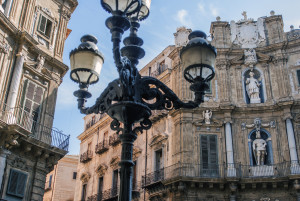Palermo is located on the island of Sicily and is the region’s capital city. It’s history has suffered 13 foreign dominations from which she has taken both the best and the worst. The invasion of so many diverse cultures has made Sicily a fascinating place, quite unlike any other…
Since the mid-19th century, Palermo was known as the hive of Mafioso activity. The genesis of the Mafia began under feudalism, whereby the nobility owned most of the land and enforced law and order through their private armies. In countryside towns that lacked formal law, local elites responded to banditry by recruiting young men into “companies-at-arms” to hunt down thieves and negotiate the return of stolen property, in exchange for a pardon for the thieves and a fee from the victims. These companies-at-arms were often made up of former bandits and criminals, usually the most skilled and violent of them. While this saved communities the trouble of training their own policemen, it may have made the companies-at-arms more inclined to collude with their former brethren rather than destroy them. On the other side of its much-debated history, my grandmother told me that the mafia actually started out as a benign organization. That it was mainly created to protect the women and children.

The Maxi Trial (1986-1987) which resulted in several hundred convictions of leading mafiosi in Palermo
Throughout the 19th century, the government maintained close ties to organized crime families, creating a web of corruption and intimidation. It wasn’t until the 1980’s when magistrates Giovanni Falcone and Paolo Borsellino began a campaign against the Cosa Nostra. The government successfully banned any Mafioso activity. It has been noted that the Mafia, or rather ‘the essence of the Mafia,’ is a way of thinking that requires a certain line of conduct, such as maintaining one’s pride or even bullying in a given situation.
Beginning our tour on foot, the first stop was Teatro Massimo Bellini Opera House, named after the local-born composer Vincenzo Bellini. From its beginnings in 1890, a wide variety of operas have been performed in the 1,200 seat theatre. In 1951, to mark the 150th anniversary of the birth of Bellini, the great Maria Callas sang Bellini’s masterwork Norma. The Theatre has also been immortalized on film. In the final moments of The Godfather: Part III, Mary, the daughter of Al Pacino’s Don Corleone, is shot on the steps of the grand Opera house.
Everyone on the tour struggled to keep up and not get horribly lost in the medieval, narrow, winding streets of Palermo. We arrived at the crowded Capo Market– to left and right, there were assortments of every food imaginable and vendors barking out to anybody who would listen. My personal attention was drawn to the pungent smell of Sicilian pizza and the various glass cases of colorful gelato.
So what exactly is Sicilian pizza? Sicilian pizza is often synonymous with thick-crust or deep-dish pizza. Traditionally, it’s topped with onions, anchovies, tomatoes, herbs, and strong cheese such as Caciocavallo and Toma. It’s been popular on the island as far back as the 1860s.
As for the gelato… the origins of Sicilian gelato have been debated for many years. Some theories support a Greek, Roman or Arab creation. Based on historical records, it’s believed that in Palermo’s ancient Greek or Roman days, foot runners brought snow from Mount Etna to the city of Taormina, to be flavored with nuts, berries and honey. It was a treat reserved only for aristocrats. In the 9th century, the Arabs introduced sugar cane, and this revolutionized Sicilian cooking. Before the 9th century local honey was used to sweeten Sicilian ices and sorbets. Sicilian gelato, as it has come to us, is probably an Arab invention based on sorbet made with cane sugar. There is something in the Sicilian gelato that is addictive…my personal taste buds were twirling from the sweet and sour icy ‘snow’– whatever it’s origins.
In the very center of the bustling Capo market, following on the heels of our guide, we entered through a nondescript door and unexpectedly stepped into the awe inspiring nave of the Church of the Immaculate Conception. Built quickly, in just a few months in 1612, the Church’s beautiful architecture is Baroque and decorated in multicolored marbled inlay and bas-relief.
Roman Catholicism is very important in Palermitan culture. The patron saint of the city is Saint Rosalia (1130-1166). There is a sanctuary dedicated to her that sits 2,000ft high on the towering Mount Pellegrino, with its astonishing views of the city and surrounding mountains.
We continued into the historic heart of Palermo via Quattro Canti– a baroque square, octagonal in shape, leading to four different streets and divided by four different buildings. The near-identical facades of the buildings contain fountains with statues of the four seasons, the four Spanish kings of Sicily, and of the four patronesses of Palermo. There are Italian and Arab shops on Quattro Canti, including a fascinating ventriloquist shop with handmade puppets staring out at you through the window.
Walking the streets of Palermo, I couldn’t help but notice the huge population of stray German Shepherds lying on the ground – looking half dead. I stopped and poured water into a bowl for one dog. She wouldn’t drink it. Next, I tried putting pizza crust in front of her mouth, she wasn’t interested. There were so many of these stray dogs in Palermo. I guess they’re just tired of pizza–and tourists!
Sicilians build things like they will live forever and eat like they will die tomorrow.
-Plato
All photographs except #2-3, 5, 7, 15 taken by Ryan Oksenberg

























Always fascinating. I did get to Syracusa which I loved. The sea food was scrumptious!!